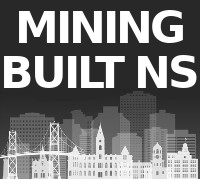- Why Mining Matters
- Jobs
- Safety
- Environment & Operations
- FAQ
- Links
- Fun Stuff
You are here

Thomas J. Brown
BESCO’s Pension
Dan McIsaac and Jim Taylor
Tius Tutty
Wilson Beaton
Aerotech Connector
Henry Swift
1885 Vale Tour
Douglas Slope Explosion
John Angus MacNeil and WWI
Florence Colliery
Joseph Walton
James Lennon
James Hamilton
1918 Allan Mine Disaster
Robert Boutilier’s Luck
Springhill’s John Anderson
Plight of Youth in 1931
Miners’ Wives Praised
Dominion No. 1B in 1931
Allan Shaft, 1931
Private Maceachern
Husseys Prospectus
William Routledge
Swell Factor in Reclamation
Gowrie Mine
River Hebert
Joggins 1904 Fire
Port Hood 1911 Flood
Lamp Cabin Memorial Park
Drummond 1873 Disaster
1872 Accidents
Springhill’s Novaco Mine
1860's Accident
New Glasgow's Linacy Mine
1913 Drummond Fires
1908 Princess Fire
Albion Mines 1913 Fire
DOSCO Miner
Cape Breton's TNT
The McCormick and Turner families
Payday Drunk
John Croak’s Victoria Cross
Atlantic Slag Company
Sydney Cement Company
1914 Coal Mine Cost
Dominion No 2
Canary in a Coal Mine
Draegermen
James Dinn
Pit Ponies
Henry Wadsworth Longfellow
1877 Accidents
Allan Shaft 1912
William Fleming
The Story of Peat
T. G. MacKenzie
Trenton Steel
1930 Stats
MacGregor Mine Explosion
MacGregor Flood
Torbanite Products Limited
Abraham Gesner and Kerosene
1860 Prince of Wales Visit
Dominion No 5
The Royal William and Stellarton Coal
Tom Pit
Terminal City
1875 Accidents
Cannons in Coal Mines
Princess Mine Explosion
Dominion No. 26
A Tale of Two Mines
Franklin Colliery
Robert J. Grant
Springhill No. 1
Mother Coo
Submarine Mines
Barrachois Mine
Fundy Coal Seam
Dominion #14
Dominion #12
Dominion No 4
Child Labour
Joggins Colliery
Safety
Bootleggers
Richmond County
Mabou Mines
Stellar Coal
English Slope
Maccan/Jubilee
The Foster Pit Fire and the Poop Solution
Thomas Edison and the Chignecto coal mine
Henry Whitney and the Dominion Coal Company
Foord Pit
Hiawatha Coal Mine
Coalburn
Springhill Disasters
St. Rose-Chimney Coalfield
Stellarton, Dorrington Softball Complex
How Does Coal Form?
Drummond Coal Mine
Sydney Coalfield and the Princess Mine
Port Morien, 1720
Port Hood
General Mining Association
Thorburn
WWII and Nova Scotia Coal
Nova Scotia's First Railway
Samuel Cunard
Stellarton’s Mining Connections
Sydney Mines
Point Aconi
Victoria Mines
Sullivan Creek
New Campbellton
Inverness and Cabot Links
The Ghost Town of Broughton
Tobin Road, Sydney Mines
Flint Island Coal Mine?!
What does Colliery mean?
Cottam Settlement
Allan Mine
Springhill’s John Anderson
Springhill may owe its existence to John Anderson more than anyone else. At least that’s what the Halifax Herald wrote in 1902, because Anderson discovered the coal seams that caused Springhill to grow from a tiny village to a thriving mining town.
John Anderson was born in Lanarkshire, Scotland, around 1818. At a young age, he started working in a Scottish coal mine at which his father was the underground manager. He studied geology and was “Naturally studious,” according to the Halifax Herald’s August 28, 1902, edition.
His opportunities were limited in Scotland, so he immigrated to Nova Scotia in 1852, planning to work at Albion Mines (Stellarton’s original name), where the General Mining Association (GMA) operated a number of coal mines. However, he could only find work as a labourer, so he travelled on foot to the Albert coal mines in New Brunswick where he worked for a while. He later travelled to Grand Lake, NB, where he ran his own mine and shipped the coal by wooden boats to Saint John.
He returned to Nova Scotia in 1865 and explored for coal in the Joggins and River Hebert districts.
In 1868, Anderson was hired by investors to explore the Springhill coalfield. It had been known for decades that coal existed in the area - coal mining started in Springhill as early as 1834 when a local man sold coal to blacksmiths. Some small-scale mining took place starting in the late 1850s after the GMA lost its 30-year monopoly on most Nova Scotia minerals and independent operators were allowed to open mines.
However, those companies “were all baffled in finding upon them workable seams of coal,” as the Herald put it in 1902. “Mr. Anderson’s task was to find coal where others had failed. Mr. Anderson laboured for three or four years under difficulties for want of equipment and supplies, but was successful in tracing valuable seams of coal and laying the foundation for the great coal mining enterprise now carried on by the Cumberland Railway and Coal Company.”
Anderson’s discoveries first led to the formation of the Springhill Mining Company in 1872, and “About a dozen coal cutters were employed that season….” A branch railway was built to connect Springhill to the Intercolonial Railway and, with this important improvement in transportation, the town’s mines were opened on a larger scale.
Springhill transitioned from a village of “rude shacks in which the first rush of settlers contrived to live and do their business” to a thriving town that would have an extraordinary history of coal mining over the next century.
The Herald wrote, “Springhill today [in 1902] is an object lesson upon the enormous hidden wealth of the province and what is due to the early explorers and promoters of these great coal works.”
Anderson was briefly manager of the mines until he retired in 1873, according to the Herald, “primarily owing to ill health, and was afterwards appointed post-master….”
The newspaper said Anderson was “probably deserving of more credit than any other man for bringing about the development of the Springhill mines.” It described him as “A man of rare intelligence and individuality….”
Anderson, who had asthma with which “he has been afflicted more or less all his life,” passed away on August 31, 1903, at the age of 85 “after much patient suffering,” according to the Evening Mail’s September 5 edition.
Today, “the enormous hidden wealth of the province” is still an essential part of Nova Scotia’s economy. Nova Scotia’s mining and quarrying industry employs over 3000 Nova Scotians, mostly in rural areas, and its average total compensation (wages and benefits) is $102,000 per year.

















































































